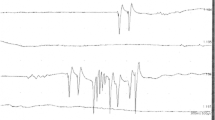Summary
Paroxysmal dysarthria and ataxia (PDA) is a rare, nonepileptic seizure syndrome which is pathognomonic for multiple sclerosis and is easily recognizable by its uniform pattern, as is to be noted in the previous literature and from our 4 new cases. It is characterized by attacks of bulbar dysarthria and severe ataxia which last up to 15 sec, rarely longer, and may occur up to 200 times a day. Sometimes they may be associated with visual disturbances and trigeminal paraesthesiae.
Espir et al. have suggested the plausible hypothesis that the syndrome is due to axonal functional lability associated with the beginning demyelinating process and, although function is maintained, it can break down as a consequence of changes in the internal environment (hypoxia, hyperthermia, regulatory rhythms, etc.). PDA responds well to small doses of carbamazepine (Tegretol, 400–600 mg daily) which, by reducing neuronal transsynaptic excitability, is believed to lead to a diminished neuronal performance with which the reduced functional capacity of the axones can still cope. The question of localization is discussed. The lesions are believed to lie in the bilateral paramedian region of the caud pars dorsalis pontis, where the cortico-bulbar fibres approach the lemniscus medialis. Visual disturbances would be due to an extension of the lesion(s) to either the nucleus n. abducentis of one side or, more probably, the fasciculus longitudinalis medialis. A more lateralised lesion may reach the crossing fibres from the nucleus principalis n. trigemini, and so cause the unilateral trigeminal paraesthesiae.
Zusammenfassung
Die paroxysmale Dysarthrie und Ataxie (PDA), über die wir die bisherige Literatur referieren und 4 eigene Beobachtungen mitteilen, ist ein seltenes, nichtepileptisches, für eine MS pathognomonisches, durch seinen gleichförmigen Ablauf leicht identifizierbares Anfallssyndrom. Es äußert sich in täglich mehrmals bis gehäuft auftretenden Anfällen von bulbärer Dysarthrie und schwerer Ataxie, die wenige bis 15 sec, selten etwas länger dauern. Manchmal können Sehstörungen oder Paraesthesien im Trigeminusbereich hinzutreten. Eine Verwechslung mit anderen, vor allem mit epileptischen Anfällen ist ausgeschlossen.
Zur Pathogenese haben Espir et al. die plausible Hypothese geäußert, daß der PDA eine durch den beginnenden demyelinisierenden Prozeß hervorgerufene Funktionslabilität der Axone zugrunde liegt; die Funktion ist eben noch erhalten, kann aber bei Veränderungen des inneren Milieus (Hypoxie, Hyperthermie, regulatorische Rhythmen etc.) zusammenbrechen. Die PDA ist mit kleinen Dosen von Carbamazepin (Tegretal 400–600 mg täglich) gut therapierbar. Mit dem Ende des demyelinisierenden Schubs geht sie in Remission oder Defekt über.
Die Frage der Lokalisation wird diskutiert, ebenso der mögliche Wirkungsmechanismus des Carbamazepin.
Similar content being viewed by others
Literatur
Andermann, F., Cosgrove, J. B. R., Lloyd-Smith, D., Walters, A. M.: Paroxysmal dysarthria and ataxia in multiple sclerosis. A report of 2 unusual cases. Neurology (Minneap.) 9, 211–215 (1959)
Castaigne, P., Cambier, J., Masson, M., Brunet, P., Lechevallier, B., Delaporte, P., Dehen, H.: Les manifestations motrices paroxystiques de la sclérose en plaques. Presse méd. 78, 1921–1924 (1970)
Davis, F. A.: Axonal conduction studies based on some considerations of temperature effects in multiple sclerosis. Electroenceph. clin. Neurophysiol. 28, 281–286 (1970)
Edmund, J., Fog, T.: Visual and motor instability in multiple sclerosis. Arch. Neurol. (Chic.) 73, 316–323 (1955)
Espir, M. L. E., Millac, P.: Treatment of paroxysmal disorders in multiple sclerosis with carbamazepin (Tegretol). J. Neurol. Neurosurg. Psychiat. 33, 528–531 (1970)
Espir, M. L. E., Walker, M. E.: Carbamazepine in multiple sclerosis. Lancet 1967 I, 280
Espir, M. L. E., Watkins, S. M., Smith, H. V.: Paroxysmal dysarthria and other transient neurological disturbances in disseminated sclerosis. J. Neurol. Neurosurg. Psychiat. 29, 323–330 (1966)
Fromm, G. H., Kohli, C. M.: The role of inhibitory pathways in petit mal epilepsy. Neurology (Minneap.) 22, 1012–1020 (1972)
Harrison, M., McGill, J. I.: Transient neurological disturbances in disseminated sclerosis: a case report. J. Neurol. Neurosurg. Psychiat. 32, 230–232 (1969)
Hopf, H. C., Stamatović, A. M., Wahren, W.: Die cerebralen Anfälle bei der Multiplen Sklerose. Z. Neurol. 198, 256–279 (1970)
Matthews, W. B.: Tonic seizures in disseminated sclerosis. Brain 81, 193–206 (1958)
Miley, C. E., Forster, F. M.: Paroxysmal signs and symptoms in multiple sclerosis. Neurology (Minneap.) 24, 458–461 (1974)
Mumenthaler, M., Hecker, A.: Klinik und Zuordnung tonischer Hirnstammanfälle anhand von 27 eigenen Beobachtungen. Fortschr. Neurol. Psychiat. 41, 623–639 (1973)
Namerow, N. S.: Circadian temperature rhythm and vision in multiple sclerosis. Neurology (Minneap.) 18, 417–422 (1968)
Nelson, D. A., McDowell, F.: The effects of induced hyperthermia on patients with multiple sclerosis. J. Neurol. Neurosurg. Psychiat. 22, 113–116 (1959)
Watson, C. W.: Effect of lowering body temperature on the symptoms and signs of multiple sclerosis. New Engl. J. Med. 261, 1253–1259 (1959)
Author information
Authors and Affiliations
Rights and permissions
About this article
Cite this article
Wolf, P., Assmus, H. Paroxysmale Dysarthrie und Ataxie. J. Neurol. 208, 27–38 (1974). https://doi.org/10.1007/BF00313331
Received:
Issue Date:
DOI: https://doi.org/10.1007/BF00313331




